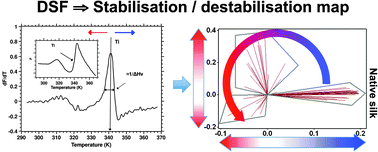Differential scanning fluorimetry illuminates silk feedstock stability and processability†
Abstract
The ability to design and implement silk feedstock formulations for tailored spinning has so far eluded the bioengineers. Recently, the high throughput screening technique of differential scanning fluorimetry (DSF) demonstrated the link between the instability transition temperature (Ti) and the processability of the silk feedstock. Using DSF we screened a large set of chemicals known to affect solvent quality. A multivariate analysis of the results shows that, regardless of the diversity of chemicals, three groupings are significantly distinguishable: G1 = similar to native silk; G2 = largely dominated by electrostatic interactions; and G3 = dominated by chelating interactions. We propose a thermodynamic analysis based on a pre- and post-transition fit to estimate the van't Hoff enthalpies (ΔHv) and the instability temperature (Ti). Our analysis shows that the ΔTi and ΔHv values were distinct: G1 (ΔTi = 0.23 ± 0.2; ΔHv = −159.1 ± 5.6 kcal mol−1), G2 (ΔTi = −7.3 ± 0.7; ΔHv = −191.4 ± 5.5 kcal mol−1), and G3 (ΔTi = −19.9 ± 3.3; ΔHv = −68.8 ± 6.0 kcal mol−1). Our analysis further combined the ΔTi value and the ΔHv value using stability ΔΔG to find that G1 only marginally stabilizes native silks (ΔΔG = −0.15 ± 0.04 kcal mol−1), whereas G2 and G3 destabilize native silk (ΔΔG = 3.8 ± 0.11 and ΔΔG = 3.8 ± 0.3 kcal mol−1, respectively). Here our analysis shows that native silk has a complex multistep transition that is possibly non-cooperative. However, all three groupings also show a direct and cooperative transition with varied stabilization effects. This analysis suggests that native silks are able to sample multiple substates prior to undergoing (or to delay) the final transition. We conclude by hypothesizing that the observed energetic plasticity may be mediated by a fragile packaging of the silk tertiary structure that is readily lost when the solvent quality changes.

- This article is part of the themed collection: Silk and silk-inspired materials

 Please wait while we load your content...
Please wait while we load your content...